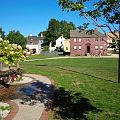Stephen Bachiler was an English clergyman who was an early proponent of the separation of church and state in the American Colonies. He was also among the first settlers of Hampton, New Hampshire.

Portsmouth is a city in Rockingham County, New Hampshire, United States. At the 2020 census it had a population of 21,956. A historic seaport and popular summer tourist destination on the Piscataqua River bordering the state of Maine, Portsmouth was formerly the home of the Strategic Air Command's Pease Air Force Base, since converted to Portsmouth International Airport at Pease.

Rye is a town in Rockingham County, New Hampshire, United States. The population was 5,543 at the 2020 census. The town is home to several state parks along the Atlantic coastline.
Robert Joseph Vila is an American home improvement television show host known for This Old House (1979–1989), Bob Vila's Home Again (1990–2005), and Bob Vila (2005–2007).

Thomas Bailey Aldrich was an American writer, poet, critic, and editor. He is notable for his long editorship of The Atlantic Monthly, during which he published writers including Charles W. Chesnutt. He was also known for his semi-autobiographical book The Story of a Bad Boy, which established the "bad boy's book" subgenre in nineteenth-century American literature, and for his poetry.

The Seacoast Region is the southeast area of the U.S. state of New Hampshire that is centered around the city of Portsmouth. It includes the eastern portion of Rockingham County and the southern portion of Strafford County. At its narrowest definition, the region stretches 13 miles (21 km) along the Atlantic Ocean from New Hampshire's border with Salisbury, Massachusetts, to the Piscataqua River and New Hampshire's border with Kittery, Maine. The shoreline alternates between rocky and rough headlands and areas with sandy beaches. Some of the beaches are bordered by jetties or groins, particularly in the towns of Rye and Hampton. Most definitions of the Seacoast Region includes some inland towns as well, including the Great Bay area cities of Dover and Rochester, the college town of Durham, and areas as far west as Epping. Some definitions also include nearby portions of York County, Maine that are culturally aligned with the Portsmouth area rather than the Portland, Maine metropolitan area.

His Majesty's Naval Base, Portsmouth is one of three operating bases in the United Kingdom for the Royal Navy. Portsmouth Naval Base is part of the city of Portsmouth; it is located on the eastern shore of Portsmouth Harbour, north of the Solent and the Isle of Wight. For centuries it was officially known as HM Dockyard, Portsmouth: as a Royal Dockyard, Portsmouth functioned primarily as a state-owned facility for building, repairing and maintaining warships; for a time it was the largest industrial site in the world.

The D-Day Story is a visitor attraction located in Southsea, Portsmouth in Hampshire, England. It tells the story of Operation Overlord during the Normandy D-Day landings. Originally opened as the D-Day Museum in 1984 by Queen Elizabeth The Queen Mother, it reopened as the D-Day Story, following a refurbishment funded by a £5 million Heritage Lottery grant, in March 2018. The museum building was designed by the then city architect Ken Norrish.
John Sherburne was an emigrant from England to New England. He arrived at Portsmouth, New Hampshire, on June 12, 1632 aboard the "James" with his brother Henry Sherburne. They were early New England pioneers, penniless despite aristocratic connections in England, and rose to considerable wealth in colonial New Hampshire. John Samuel Sherburne,, a prominent colonial and early American politician in New England, was Sherburne's descendant, as was John Sherburne Sleeper (1794–1878).

Martha Fuller Clark is a former Democratic member of the New Hampshire Senate, representing the 21st district from 2012 until 2020 and the 24th district from 2004 until 2010. Prior to her Senate service she was a member of the New Hampshire House of Representatives from 1990 through 2002.

St. John's Church is a historic church at 101 Chapel Street in Portsmouth, New Hampshire, United States. The brick building was designed by Alexander Parris and built in 1807; it was the first brick church in the state of New Hampshire, and is a rare surviving early design by Parris. The building was listed on the National Register of Historic Places in 1978. The church is home to an Episcopal congregation organized in 1732, with roots in the city's 17th-century founding.

Albert Gallatin Hoit was an American painter who lived in Boston, Massachusetts. He painted portraits of William Henry Harrison, Daniel Webster and Brenton Halliburton.

Andrew Harry Jarvis was a Greek-American politician and businessman from New Hampshire.

The Story of a Bad Boy (1870) is a semi-autobiographical novel by American writer Thomas Bailey Aldrich, fictionalizing his experiences as a boy in Portsmouth, New Hampshire. The book is considered the first in the "bad boy" genre of literature, though the text's opening lines admit that he was "not such a very bad, but a pretty bad boy".

The Portsmouth Cottage Hospital was the first hospital built in the city of Portsmouth, New Hampshire. Opened in 1884, it was one of the first hospitals in New Hampshire, and it served as the city's primary hospital facility until 1986, when Portsmouth Regional Hospital opened. Its 1895 campus has been repurposed to house city offices and the police station, and a senior living facility. A portion of that facility, representing its oldest buildings, was listed on the National Register of Historic Places in 1996.

The Shapley Town House, also known as the Reuben Shapley House, is a historic house at 454-456 Court Street in Portsmouth, New Hampshire. Built about 1815, it is unusual in the city as a particularly well-preserved example of a Federal period double house. The house was listed on the National Register of Historic Places in 1973. It is owned by the Strawbery Banke Foundation.
Pannaway Plantation was the first European settlement in what is now currently the state of New Hampshire. By 1630, the plantation was abandoned, and the settlers moved to Strawbery Banke in what is now Portsmouth. Pannaway Plantation was settled on land that is now in Odiorne Point State Park in the town of Rye.

The Portsmouth Downtown Historic District encompasses the historic urban core of Portsmouth, New Hampshire. With a history dating to the 17th century, Portsmouth was New Hampshire's principal seaport and the center of its economy for many decades, and the architecture of its urban center is reflective of nearly four centuries of history. The district is roughly L-shaped, radiating from the downtown Market Square area to South Street in the south and Madison and Columbia streets in the west, with more than 1,200 historically significant buildings. It was listed on the National Register of Historic Places in 2017. The district includes 35 previous listings on the National Register, and five National Historic Landmarks.

The Joshua Wentworth House is an historic building in Portsmouth, New Hampshire, which was formerly individually listed in the National Register of Historic Places. The building was again listed in 1975 as a contributing resource to the Strawbery Banke Historic District and is a contributing resource to the Portsmouth Downtown Historic District placed on the National Register of Historic Places in 2017.
Jane Nylander is an American historian and author. She is known for her work on textiles and used buildings to describe life in past eras.

























